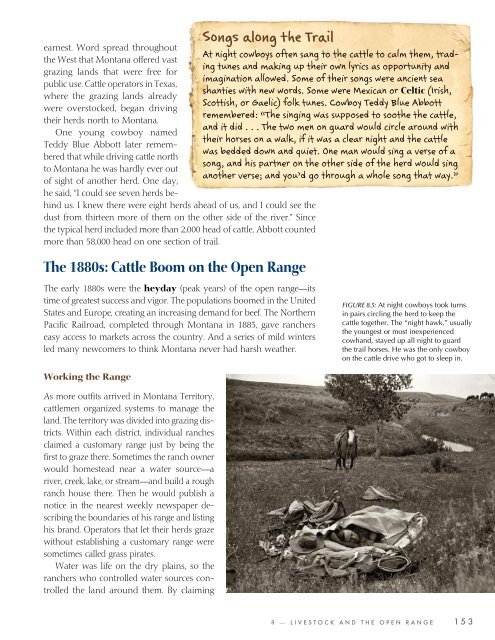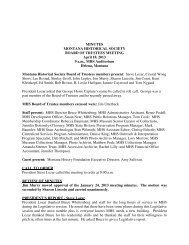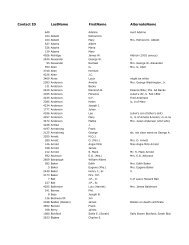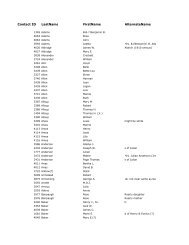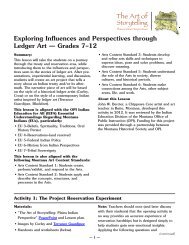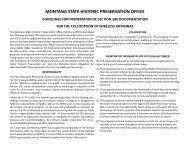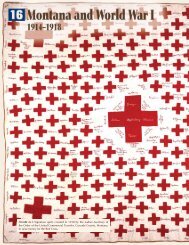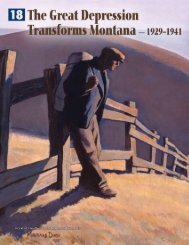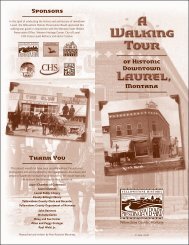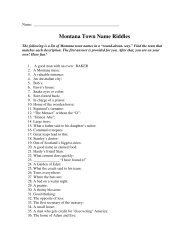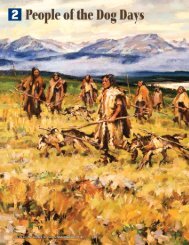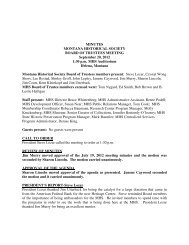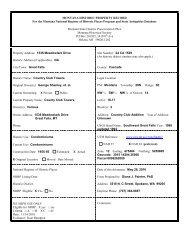148 1830s 1850 1840 1845 1855 1860 - Montana Historical Society
148 1830s 1850 1840 1845 1855 1860 - Montana Historical Society
148 1830s 1850 1840 1845 1855 1860 - Montana Historical Society
You also want an ePaper? Increase the reach of your titles
YUMPU automatically turns print PDFs into web optimized ePapers that Google loves.
Songs along the Trail<br />
earnest. Word spread throughout<br />
At night cowboys often sang to the cattle to calm them, trad-<br />
the West that <strong>Montana</strong> offered vast<br />
ing tunes and making up their own lyrics as opportunity and<br />
grazing lands that were free for<br />
imagination allowed. Some of their songs were ancient sea<br />
public use. Cattle operators in Texas,<br />
shanties with new words. Some were Mexican or Celtic (Irish,<br />
where the grazing lands already<br />
Scottish, or Gaelic) folk tunes. Cowboy Teddy Blue Abbott<br />
were overstocked, began driving<br />
remembered: “The singing was supposed to soothe the cattle,<br />
their herds north to <strong>Montana</strong>.<br />
and it did . . . The two men on guard would circle around with<br />
One young cowboy named<br />
their horses on a walk, if it was a clear night and the cattle<br />
Teddy Blue Abbott later remem-<br />
was bedded down and quiet. One man would sing a verse of a<br />
bered that while driving cattle north<br />
song, and his partner on the other side of the herd would sing<br />
to <strong>Montana</strong> he was hardly ever out<br />
another verse; and you’d go through a whole song that way.”<br />
of sight of another herd. One day,<br />
he said, “I could see seven herds behind<br />
us. I knew there were eight herds ahead of us, and I could see the<br />
dust from thirteen more of them on the other side of the river.” Since<br />
the typical herd included more than 2,000 head of cattle, Abbott counted<br />
more than 58,000 head on one section of trail.<br />
The 1880s: Cattle Boom on the Open Range<br />
The early 1880s were the heyday (peak years) of the open range—its<br />
time of greatest success and vigor. The populations boomed in the United<br />
States and Europe, creating an increasing demand for beef. The Northern<br />
Pacifi c Railroad, completed through <strong>Montana</strong> in 1883, gave ranchers<br />
easy access to markets across the country. And a series of mild winters<br />
led many newcomers to think <strong>Montana</strong> never had harsh weather.<br />
Working the Range<br />
As more outfi ts arrived in <strong>Montana</strong> Territory,<br />
cattlemen organized systems to manage the<br />
land. The territory was divided into grazing districts.<br />
Within each district, individual ranches<br />
claimed a customary range just by being the<br />
fi rst to graze there. Sometimes the ranch owner<br />
would homestead near a water source—a<br />
river, creek, lake, or stream—and build a rough<br />
ranch house there. Then he would publish a<br />
notice in the nearest weekly newspaper describing<br />
the boundaries of his range and listing<br />
his brand. Operators that let their herds graze<br />
without establishing a customary range were<br />
sometimes called grass pirates.<br />
Water was life on the dry plains, so the<br />
ranchers who controlled water sources controlled<br />
the land around them. By claiming<br />
FIGURE 8.5: At night cowboys took turns<br />
in pairs circling the herd to keep the<br />
cattle together. The “night hawk,” usually<br />
the youngest or most inexperienced<br />
cowhand, stayed up all night to guard<br />
the trail horses. He was the only cowboy<br />
on the cattle drive who got to sleep in.<br />
8 — L I V E S T O C K A N D T H E O P E N R A N G E 1 5 3


